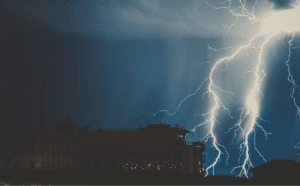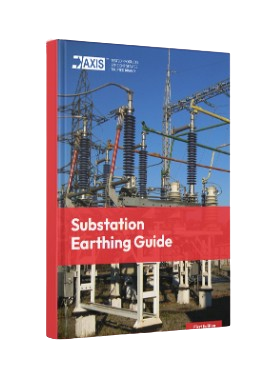Petrol stations are high-risk locations considering the huge explosion that can happen due to any small ignition from lightning strikes or other sources. There are special building regulations in the case of petrol stations considering these risk factors. The lightning protection for petrol stations must be designed based on the various techniques and methods specified in different standards. The NFPA 780 describes the safety requirements for the lightning protection of structures containing flammable liquids, gases or vapours. Also, the lightning protection system design must be in accordance with IEC 62305 and NBC 2016 guidelines. The lightning protection for petrol stations is discussed here based on these various standards.
Possible Risks in Petrol Stations:
Lightning strike events can ignite flammable liquids or vapours in a petrol station in different ways. The following are some of the causes of the ignition of flammable fuels and other hazardous events that can occur.
1) Direct Strike:
Direct lightning strikes can cause physical damage or fire to the entire structure. It can destroy the electrical and electronic systems in the area. The petrol station structure and the canopies for the vending machine need to be protected from these direct strikes using a well-designed external lightning protection system.
2) Lightning Electromagnetic Pulse:
The electromagnetic pulse created by lightning within the magnetic field will induce voltages on any nearby conductors. The voltage induced can go up to 500 kV/microsecond. These induced voltages can vary according to the intensity of the strike. It can be in the sizeable potential of volts, but low energy too. However, these voltages can also lead to spark generation and result in explosions. Hence, it is recommended to use equipotential bonding and surge protection measures to safeguard critical equipment and electronic components from the lightning electromagnetic pulses.
3) Sensitive Electronic Systems:
The petrol station has two critical electronic systems which are very sensitive and needs dedicated earthing.
a) The Automated Tank Gauging (ATG) system
b) The Power Supply System (UPS)
The Automated Tank Gauging (ATG) is connected to equipment which monitors this system. It is a completely automated and sophisticated system that measures and controls the fuel dispensing to the vending machine and other functions. This system is usually backed up with a regulated power system or UPS because any switching surge, lightning strike or unregulated power supply can damage it. To protect this ATG and UPS there must be separate earthing and lightning protection systems. The fuel dispensing machines are also automated electronic systems with regulated power supply. All these systems are very expensive and the complete functioning of the petrol station can come to a standstill if they are affected. The downtime thus caused can also result in economic and business losses. To avoid such losses protection measures such as Lightning Protection, Surge Protection Devices and equipotential bonding must be ensured.
4) Secondary Arcing:
The flammables can take up the charge from the lightning strike. These charges are often not released within the strike neutralization period and remain in the material. Once the surroundings are neutralized, the difference in potential causes an arc called the Secondary arc, which can result in the fire of the flammable liquid. Therefore, to ensure that the charges are neutralized and for protection of the different operating systems equipotential bonding and earthing must be provided according to IEC 62305.
Protection Methods:
The first step in the design of lightning protection for petrol stations is the risk assessment. The risk assessment can be done based on the parameters specified in IEC 62305-2 to identify the possible risks. Once these risk values are identified, they must be compared with the tolerable limits and measures to reduce them to the permissible levels are to be implemented. The level of protection should also be based on the geographical location of the petrol station.
The sensitive equipment at the petrol station and the incoming power lines are the major areas vulnerable to direct lightning strikes. The fuel tanks are located underground, and the fuel dispensers are usually located under projecting metallic roofs. The lightning arresters along with the entire level of protection must be installed for the entire structure to protect from them direct strikes.
Surge arresters are installed at the entrance points of lines into the fuel dispenser and the electronic equipment connected to the dispenser. Electronic systems such as the ATG, regulated power supply systems and the control room of the petrol station need to be installed with surge arresters for protection.
The fuel storage tanks and structures are usually buried under the ground and are safe. Any exposed metallic structures or tanks of 4.8mm or greater thickness, that are electrically continuous and tightly sealed, containing flammable liquids are considered to be self-protected. They can also be installed with strike termination devices for extra protection.
The conventional lightning protection system with additional protection is used to protect the complete structure. The protection system consists of the Strike termination devices, Down conductors, Surge protection devices, Conductors, and the Ground termination system. The air terminals, down conductors and other installations should be placed considering the auto-ignition temperature of the fuel and other factors causing hazardous events.
Surge protection devices must be installed in hazardous locations according to the risk assessment and analysis. All metallic constructions, metallic pipes, fuel tanks etc. must be bonded and connected to the earth termination system.
Equipotential bonding is an important aspect of maintaining an equipotential zone within the petrol station. The ground ring electrode or ground loop must be supplemented by one or more grounding electrodes for safety. Adequately designed protection system based on soil resistivity and calculation is also important. Earthing at petrol stations must have cathodic corrosion protection and spark gaps in hazardous zones. It is also recommended to have an earth resistance of less than 10ohm for proper earthing from a lightning protection perspective.
Conclusion:
To protect the petrol station equipment from malfunctioning, damage and fire and other economic losses, it needs an earthing and lightning protection system. Hence conventional lightning protection systems with equipotential bonding and SPDs are integral for petrol stations along with additional protection measures.
Thank you for reading the blog, Axis is a leading manufacturer and supplier of Electrical Components to over 80+ Countries. Talk to our industry expert by visiting our contact us section. You can also watch our videos by our experts – click here.









